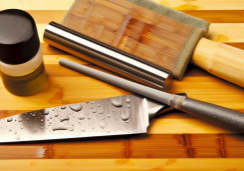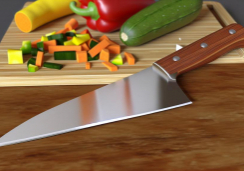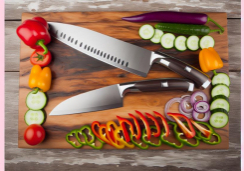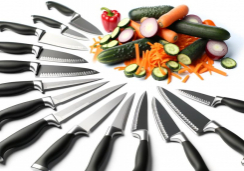Why Choose These Knives for Perfect Vegetable Chopping?
Have you ever found yourself struggling with uneven carrot slices or bruised herbs? As you stand in the kitchen, it’s not just your technique that impacts the quality of your vegetable prep—it’s also the tools you wield.
A chef’s knife, with its broad and sharp blade, offers versatility for those quick, rocking cuts, while a paring knife provides the precision necessary for the more intricate tasks. The Santoku knife, a staple in Japanese cuisine, brings efficiency and a finer edge for clean slices, and let’s not overlook a sturdy cleaver for handling tougher jobs.
Each knife has features that cater to specific cutting needs, and understanding these can transform your culinary experience from frustrating to flawless. But how do you choose the right one, and what makes these knives the ultimate go-to for vegetable chopping?
Stick around as we slice through the details, and you’ll soon find your prep work isn’t just quicker—it’s a cut above the rest.
Essential Features of Vegetable Knives
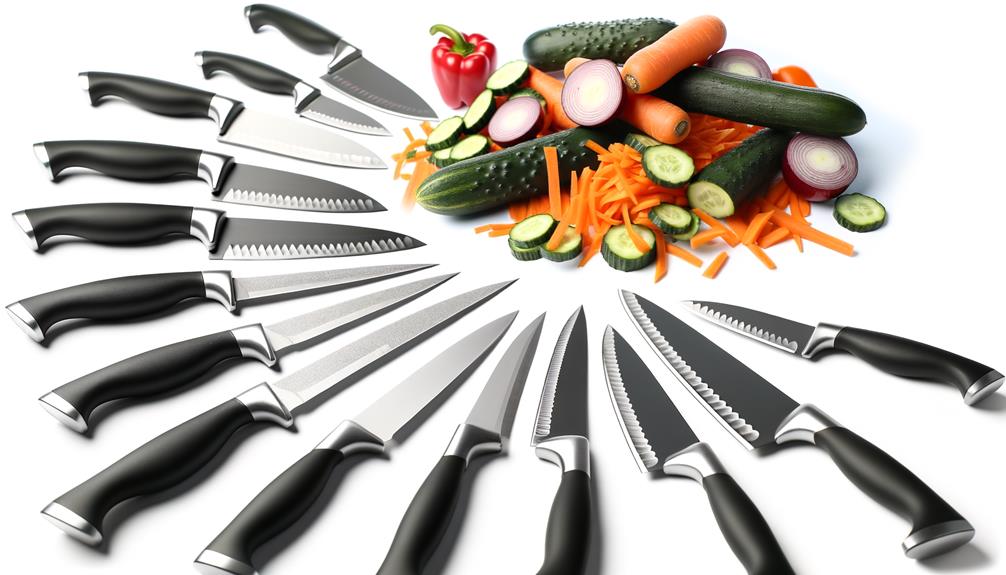
When selecting a vegetable knife, look for a sharp blade, comfortable grip, and a size that suits your chopping tasks. A dull blade can be frustrating and dangerous, requiring more force and increasing the chance of slipping. You’ll want a knife that effortlessly slices through vegetables, minimizing effort on your part.
The grip is where your hand meets the tool, so it must feel natural and secure in your hand. Look for materials that provide a non-slip surface, even when wet. Ergonomic handles that conform to your hand’s shape can reduce fatigue, especially during lengthy prep work.
Size matters when it comes to the blade. A larger knife, like a chef’s knife, is versatile but may be overkill for smaller tasks. Conversely, a paring knife is perfect for intricate work but won’t handle larger veggies well. A medium-sized santoku or utility knife often hits the sweet spot for vegetable chopping, offering enough length to handle a variety of vegetables while still allowing for precision.
Chef’s Knife Versatility
A chef’s knife excels in versatility, adeptly handling everything from slicing carrots to mincing herbs. You’ll find it’s the quintessential all-rounder in the kitchen, easily transitioning from one task to the next. Its broad, tapered shape allows for a rocking motion that’s perfect for chopping vegetables with speed and precision. Plus, the wide blade can be used to scoop up your neatly diced veggies, transferring them straight to the pan.
When you’re looking at a pile of produce that needs prepping, you don’t want to waste time switching between tools. That’s where a chef’s knife comes in handy. Its balanced weight and ergonomic handle ensure that you can keep chopping without fatigue, making it a go-to for lengthy cooking sessions.
Imagine dicing an onion: the chef’s knife’s sharp blade makes quick work of the outer layers, while the fine tip takes care of finely mincing the insides, reducing tears and time spent. And when you’re faced with something tougher, like butternut squash, the heft of a chef’s knife gives you the leverage you need to cut through with ease.
In short, it’s the one knife that’ll stand by you through thick and thin, proving indispensable for your vegetable chopping needs.
Paring Knife Precision
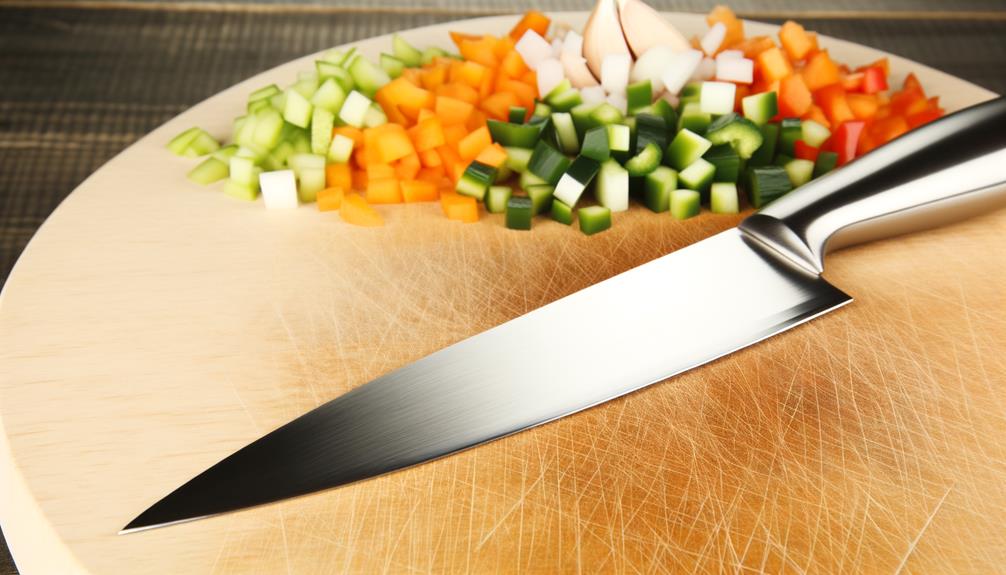
For delicate tasks like peeling apples or deveining shrimp, you’ll find the paring knife’s nimble blade indispensable. Its small size and sharp edge allow you to maneuver through the tightest spaces with precision. Here’s what sets the paring knife apart from others when it comes to prepping your veggies:
- Size and Control
- Small, typically 3-4 inches in length
- Allows for greater control than larger knives
- Ideal for intricate work where a chef’s knife is unwieldy
- Versatility
- Not just for peeling; it’s a multitasker
- Excels at tasks like:
- Hulling strawberries
- Slicing small garnishes
- Carving designs into fruit and vegetables
- Precision
- Sharp point easily pierces through skins without crushing
- Perfect for:
- Removing seeds from jalapeños
- Slicing small, delicate herbs
- Making citrus zest without the bitter pith
When you’re working with vegetables that require finesse, like trimming green beans or crafting a cucumber garnish, the paring knife is your go-to tool. It’s the unsung hero of the knife block that, once mastered, you’ll wonder how you ever managed without. So, don’t overlook this culinary powerhouse; embrace its precision for flawless vegetable prep.
Santoku Knife Efficiency
While the paring knife excels in precision tasks, the Santoku knife shines in efficiency, providing a versatile solution for chopping vegetables quickly and uniformly. Its design focuses on minimizing the time you spend prepping your ingredients. With its wide blade, the Santoku allows you to scoop up your chopped veggies with ease, streamlining the transition from cutting board to pan.
You’ll notice the Santoku’s shorter, balanced length is ideal for a swift, downward chop rather than the rocking motion associated with chef’s knives. It’s a game-changer if you’re looking to speed up your meal prep without sacrificing precision. The blade typically features hollow-edge depressions, which create air pockets to prevent food from sticking. This means you can slice through a cucumber or carve up an eggplant without pausing to clear the blade.
The Santoku is also incredibly user-friendly. Its balanced weight distribution ensures that your hand won’t tire as quickly, allowing you to chop large quantities of vegetables comfortably. Whether you’re dicing onions, mincing garlic, or slicing bell peppers, the Santoku knife helps you maintain a consistent size and shape, crucial for even cooking.
Make it your go-to for efficiency in the kitchen, and you’ll find that it’s an indispensable tool for your vegetable chopping needs.
Cleaver for Rough Cuts
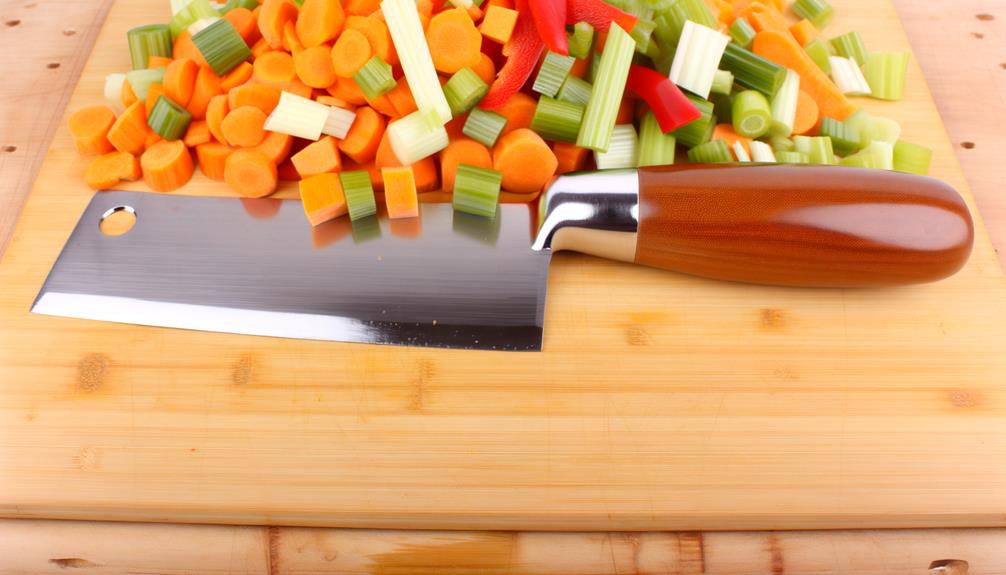
When tackling tough vegetables or disjointing meat, you’ll find the sturdy cleaver indispensable in your culinary arsenal. Unlike other knives that require a delicate touch, the cleaver’s heft and sharp edge make it perfect for those rough cuts that other blades can’t handle. Here’s why you should reach for a cleaver:
- Heavy-duty construction
- Built to withstand repeated blows on hard surfaces
- Thick blade prevents flexing and wobbling
- Designed for durability and longevity
- Versatile functionality
- Ideal for chopping large, dense vegetables like squashes and root veggies
- Can also slice through meat and bones with minimal effort
- Useful for crushing garlic or ginger with the blade’s broad side
- Ergonomic handling
- Offers a comfortable grip to manage the knife’s weight
- Balanced to give you control despite its size
- Safety is enhanced with a non-slip handle
With a cleaver in hand, you’re not just slicing—you’re powering through your prep work. It’s not about sawing or precise cuts; it’s about that one decisive motion that splits a pumpkin or severs joints. Incorporate a cleaver into your kitchen routine, and you’ll see how it transforms your approach to those tougher tasks.
What Makes These Knives the Best Choice for Perfect Vegetable Chopping?
When it comes to perfect vegetable chopping knives, precision and durability are key. These top-notch knives are designed with razor-sharp blades and ergonomic handles that provide maximum control and comfort. Their superior craftsmanship and design make them the best choice for efficient and precise vegetable chopping every time.
Conclusion
With a chef’s knife, paring knife, santoku, and cleaver in your arsenal, you’re set for veggie mastery. The chef’s knife’s versatility, the paring knife’s precision, the santoku’s efficiency, and the cleaver’s power for rough cuts make you unstoppable.
You’ll chop, dice, and slice with ease. So grab these knives and let’s make every vegetable chop a breeze. Your meals will thank you, and your prep time will shrink.
Now, let’s get chopping!

